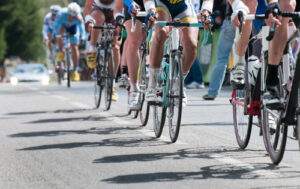Following on from yesterday’s post about taking part in long distance cycling, which can be read here, it is also worth considering the effects on the body from spending such a long time in the saddle, over and above the obvious pain that can be ameliorated by wearing some fetching padded shorts.
Road bikes will usually have the handle bars at the same height or even up to ten centimetres lower than the seat, meaning that the hips and back are bent at a sharp angle, which certainly takes some getting used to. It is common for cyclists to lack flexibility and start by struggling to get into and maintain this position. This is then compounded by poor control of the core – those muscles within the torso that keep the rest of the body stable and controlled.
When thinking of what muscles are used during cycling, the obvious answer would be ‘those in the legs’, being simplistic. Whilst it is certainly true that the calves, quadriceps and hamstrings are being used, the gluteal, hip flexor, back and even arm muscles also come into play. A study* carried out in 2010 showed that fatigue in the leg muscles produces changes in muscle movement patterns. This then starts to affect the the lower back, by increasing the amount cyclists were bending forward when out on their bikes and resulting in lower back pain. Of the injuries the cyclists in the study sustained, 45% were in the lower back and 23% in the knee, which may be surprising when the knees, along with the hips and ankles are the joints of the body continually moving.
When the leg pulls up during the pedal stroke, the hip flexors, obliques and lower back muscles are engaged to stabilize the hips and back. This should stop the hips tilting greatly from side to side. You can often see cyclists with hips moving dramatically up and down – this may be due to having the seat too high and ‘reaching’ for the pedal on the down stroke, or, more likely, it is due to core muscles not being engaged, or being so fatigued that they don’t engage any more. Strengthening the hip and back muscles is a good start to solving this. It is also important to consider other physical causes as back pain can also be brought about by an individual’s anatomy, such as those with a leg length discrepancy or spinal misalignment.
Having considered whether you are fit for your bike, is your bike fit for you? The set up of the bike should never be ignored and is as important as muscle strength and fitness when thinking of the solution to a painful problem. Having a bike that is too big, too small or has the wrong geometry for your body will certainly take its toll on the back, especially as the miles increase and fatigue sets in. This can affect cyclists who cycle long distances at the weekend, or those who commute on their bikes to work – think about how those miles in the wrong position clock up over the week. Just as hips should not sway from side to side, your knees should not be crunched nor your arms over stretched.
Here at G4 Physiotherapy & Fitness we offer a bike fitting service which can help prevent problems before they begin, as well as helping to solve them. If you have any questions, or require any other of our services please contact G4 Physiotherapy and Fitness Didsbury, Manchester by emailing admin@g4physio.co.uk or call 0161 4455133.
*Clarsen B, Krosshaug T, Bahr R. Overuse Injuries in Professional Road Cyclists Am J Sports Med 2010 Dec;38(12):2494-501.


